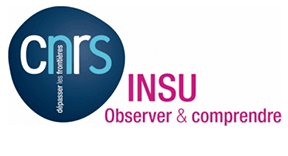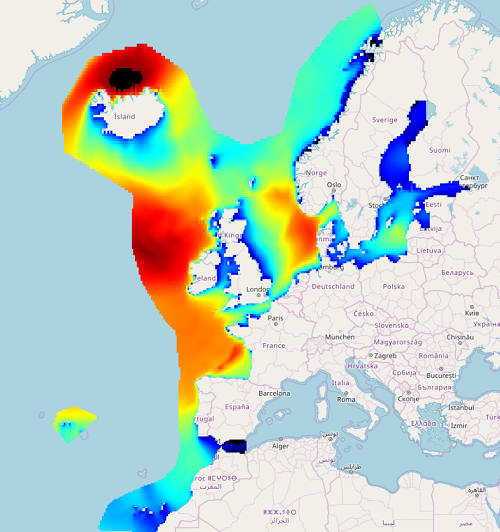Oceanographic geographical features
Type of resources
Available actions
Topics
Keywords
Contact for the resource
Provided by
Years
Formats
Representation types
Update frequencies
status
Scale
Resolution
-

SpiArcBase is a software developed for the treatment of Sediment Profile images (SPIs). Sediment Profile Images (SPIs) are widely used for benthic ecological quality assessment under various environmental stressors. The processing of the information contained in SPIs is slow and its interpretation is largely operator dependent. SpiArcBase enhances the objectivity of the information extracted from SPIs, especially for the assessment of the apparent Redox Potential Discontinuity (aRPD). This software allows the user to create and manage a database containing original SPIs and corresponding derived pieces of information. Once you have downloaded it, you can ask for help and stablish a helpdesk.
-

Daily air-sea heat fluxes dataset on the last 27 years (1992-2018). Global coverage with 0.25° resolution. Data is mainly coming from aggregated calibrated scatterometer datasets and numerical models. Main geophysical parameters are: sensible heat flux, latent heat flux, wind speed, SST, air temperature. Latest version : 4.1 released in June 2019.
-

This dataset provides extreme waves (Hs: significant wave height, Hb:breaking wave height, a proxy of the wave energy flux) simulated with the WWIII model, and extracted along global coastlines. Two simulations, including or not Tropical Cyclones (TCs) in the forcing wind field, are provided.
-
Sediment Profile Images (SPIs) are commonly used to map physical, biological and chemical/nutrient gradients in benthic habitats. SpiArcBase is a software that has been developed for the analysis of Sediment Profile Images (SPIs). It has been conceived to improve the objectivity of extracted information (especially the apparent Redox Potential Discontinuity (aRPD). The software presents a graphical user interface designed to enhance the interpretation of features observed on SPIs in an objective manner and to facilitate image management and structures visualization via a data base.The software also allows for the storage of generated data and the automatic computation of a benthic habitat quality index. The facilities provided within JERICONext include access to the software through free downloading and assistance in its utilization.
-

IOWAGA sea-states forecast best estimate generated by the wave model WAVEWATCH-III and forced by ECMWF winds on the North East Atlantic grid from 2017 to now
-
The European Organization for the Exploitation of Meteorological Satellites (EUMETSAT), Ocean and Sea Ice Satellite Application Facility (OSI SAF) is producing SST products in near realtime from Metop/AVHRR. Global AVHRR level 1b data are acquired at Meteo-France/Centre de Meteorologie Spatiale (CMS) through the EUMETSAT/EUMETCAST system. SST is retrieved from the AVHRR infrared channels (3.7, 10.8 and 12.0 m) using a multispectral algorithm. Atmospheric profiles of water vapor and temperature from a numerical weather prediction model, together with a radiative transfer model, are used to correct the multispectral algorithm for regional and seasonal biases due to changing atmospheric conditions. This product is delivered at full resolution in satellite projection as metagranule corresponding to 3 minutes of acquisition. The product format is compliant with the GHRSST Data Specification (GDS) version 2.
-
A Group for High Resolution Sea Surface Temperature (GHRSST) Level 4 sea surface temperature analysis produced daily on an operational basis at the UK Met Office using optimal interpolation (OI) on a global 0.054 degree grid. The Operational Sea Surface Temperature and Sea Ice Analysis (OSTIA) analysis uses satellite data from sensors that include the Advanced Very High Resolution Radiometer (AVHRR), the Spinning Enhanced Visible and Infrared Imager (SEVIRI), the Geostationary Operational Environmental Satellite (GOES) imager, the Infrared Atmospheric Sounding Interferometer (IASI), the Tropical Rainfall Measuring Mission Microwave Imager (TMI) and in situ data from ships, drifting and moored buoys. This analysis was specifically produced to be used as a lower boundary condition in Numerical Weather Prediction (NWP) models. This dataset adheres to the GHRSST Data Processing Specification (GDS) version 2 format specifications.
-
This is a Group for High Resolution Sea Surface Temperature (GHRSST) Level 4 sea surface temperature (SST) analysis dataset produced daily on an operational basis by the Naval Oceanographic Office (NAVO) on a global 0.1x0.1 degree grid. The K10 (NAVO 10-km gridded SST analyzed product) L4 analysis uses SST observations from the following instruments: Advanced Very High Resolution Radiometer (AVHRR), Visible Infrared Imaging Radiometer Suite (VIIRS), and Spinning Enhanced Visible and InfraRed Imager (SEVIRI). The AVHRR data for this comes from the MetOp-A, MetOp-B, and NOAA-19 satellites; VIIRS data is sourced from the Suomi_NPP satellite; SEVIRI data comes from the Meteosat-8 and -11 satellites. The age (time-lag), reliability, and resolution of the data are used in the weighted average with the analysis tuned to represent SST at a reference depth of 1-meter. Input data from the AVHRR Pathfinder 9km climatology dataset (1985-1999) is used when no new satellite SST retrievals are available after 34 days. Comparing with its predecessor (DOI: https://doi.org/10.5067/GHK10-L4N01 ), this updated dataset has no major changes in Level-4 interpolated K10 algorithm, except for using different satellite instrument data, and updating metadata and file format. The major updates include: (a) updated and enhanced the granule-level metadata information, (b) converted the SST file from GHRSST Data Specification (GDS) v1.0 to v2.0, (c) added the sea_ice_fraction variable to the product, and (d) updated the filename convention to reflect compliance with GDS v2.0. Version Description:
-
A Group for High Resolution Sea Surface Temperature (GHRSST) Level 4 sea surface temperature (SST) analysis produced daily on an operational basis at the Canadian Meteorological Center. This dataset merges infrared satellite SST at varying points in the time series from the (A)TSR series of radiometers from ERS-1, ERS-2 and Envisat, AVHRR from NOAA-16,17,18,19 and METOP-A, and microwave data from TMI, AMSR-E and Windsat in conjunction with in situ observations of SST from drifting buoys and ships from the ICOADS program. It uses the previous days analysis as the background field for the statistical interpolation used to assimilate the satellite and in situ observations. This dataset adheres to the GHRSST Data Processing Specification (GDS) version 2 format specifications.
-
A Group for High Resolution Sea Surface Temperature (GHRSST) dataset for the North Atlantic Region (NAR) from the Advanced Very High Resolution Radiometer (AVHRR) on the NOAA-19 platform (launched 6 Feb 2009). This particular dataset is produced by the European Organization for the Exploitation of Meteorological Satellites (EUMETSAT), Ocean and Sea Ice Satellite Application Facility (OSI SAF) in France. The AVHRR is a space-borne scanning sensor on the National Oceanic and Atmospheric Administration (NOAA) family of Polar Orbiting Environmental Satellites (POES) having a operational legacy that traces back to the Television Infrared Observation Satellite-N (TIROS-N) launched in 1978. AVHRR instruments measure the radiance of the Earth in 5 (or 6) relatively wide spectral bands. The first two are centered around the red (0.6 micrometer) and near-infrared (0.9 micrometer) regions, the third one is located around 3.5 micrometer, and the last two sample the emitted thermal radiation, around 11 and 12 micrometers, respectively. The legacy 5 band instrument is known as AVHRR/2 while the more recent version, the AVHRR/3 (first carried on the NOAA-15 platform), acquires data in a 6th channel located at 1.6 micrometer. Typically the 11 and 12 micron channels are used to derive sea surface temperature (SST) sometimes in combination with the 3.5 micron channel. The highest ground resolution that can be obtained from the current AVHRR instruments is 1.1 km at nadir. The NOAA-19 platform is sun synchronous generally viewing the same earth location twice a day (latitude dependent) due to the relatively large AVHRR swath of approximately 2400 km. The NAR products are SST fields derived from 1km AVHRR data that are re-mapped onto a 0.02 degree equal angle grid. In the processing chain, global AVHRR level 1b data are acquired at Centre de Meteorologie Spatiale (CMS) through the EUMETSAT/EUMETCAST system. A cloud mask is applied and SST is retrieved from the AVHRR infrared (IR) channels by using a multispectral technique. This dataset adheres to the GHRSST Data Processing Specification (GDS) version 2 format specifications.
 Catalogue PIGMA
Catalogue PIGMA